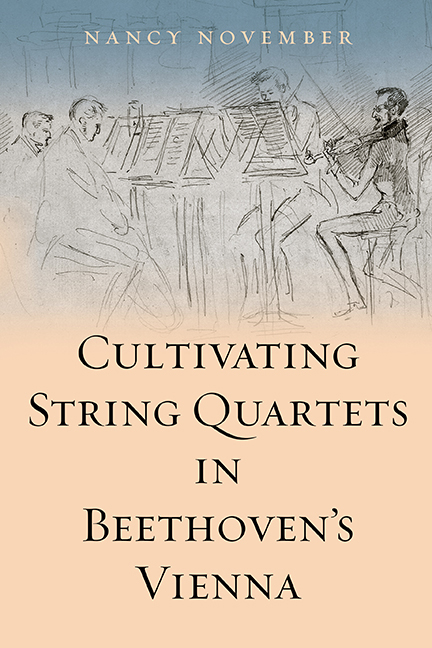Book contents
- Frontmatter
- Contents
- List of Illustrations
- List of Musical Examples
- Acknowledgements
- Introduction
- 1 Defining Chamber Music in the Early Nineteenth Century
- 2 Celebrating Haydn, Cultivating Opera
- 3 Selling String Quartets in Beethoven's Vienna
- 4 Locating String Quartets in Beethoven's Vienna
- 5 Early Nineteenth-Century Performance and Criticism
- 6 Sociability, Showmanship, and Study: ‘Quartet Friends’
- 7 The String Quartet and the Listener
- 8 Schubert's Song, Beethoven's Theatricality
- Epilogue: Constructing ‘Viennese Chamber Music’
- Bibliography
- Index
3 - Selling String Quartets in Beethoven's Vienna
Published online by Cambridge University Press: 16 May 2018
- Frontmatter
- Contents
- List of Illustrations
- List of Musical Examples
- Acknowledgements
- Introduction
- 1 Defining Chamber Music in the Early Nineteenth Century
- 2 Celebrating Haydn, Cultivating Opera
- 3 Selling String Quartets in Beethoven's Vienna
- 4 Locating String Quartets in Beethoven's Vienna
- 5 Early Nineteenth-Century Performance and Criticism
- 6 Sociability, Showmanship, and Study: ‘Quartet Friends’
- 7 The String Quartet and the Listener
- 8 Schubert's Song, Beethoven's Theatricality
- Epilogue: Constructing ‘Viennese Chamber Music’
- Bibliography
- Index
Summary
Viennese quartet composers around 1800 looked to Haydn for inspiration; for dissemination they were also well served by local resources. We can speak of a veritable ‘quartet boom’ in printing and publishing in Vienna at this time. Several new and significant presses – firms like Artaria and Bureau des Arts et d'Industrie – rivalled the output of the Parisian houses in the quality and quantity of their output, and forged ahead with newer technologies for music publishing, like engraving and lithography. This thriving industry played a key role in the outstanding production of string quartets at this time. But the flourishing of the string quartet in Vienna, and chamber music in general, was driven as much by the market as by the technology – and by Haydn's impetus. New music printing technologies were developing at the right time and in the right place. They facilitated a quartet boom fuelled by the Viennese amateur musicians’ desire for small-scale, relatively simple music for flexible forces, at a time of socio-political disruption and high inflation. A self-reinforcing cycle operated in the emerging Viennese print culture, in which composers and publishers took advantage of market exigencies, while buyers reaped the benefits of cheaper music and wider distribution.
This chapter considers the marketing of chamber music in Vienna around 1800, with special attention to string quartets. Analysis of Viennese publishers’ catalogues from the era is central here. They provide information on the distribution of chamber music by composer and genre, and demonstrate cultivation of the string quartet, above all, in this period. But they also reveal vagueness in defining genres such as ‘string quartet’, and show that several other chamber genres, notably the string quintet, were also very popular. In examining this complex market, the printing and design practices used by publishers are taken into account, especially the use of decorative title pages for marketing canonical and more ephemeral works alike.
Publication patterns changed during the period. Trends towards generic decline and demise can be traced in the Viennese symphony, while the Viennese string quartet continued to flourish. The 1799 Viennese publishing catalogue of Johann Traeg and its 1804 supplement are invaluable aids for charting this change. However, apparent evidence of a genre's decline must be read carefully, taking into account the non-chamber works, especially operas but also symphonies, that were arranged as chamber music.
- Type
- Chapter
- Information
- Cultivating String Quartets in Beethoven's Vienna , pp. 60 - 90Publisher: Boydell & BrewerPrint publication year: 2017

